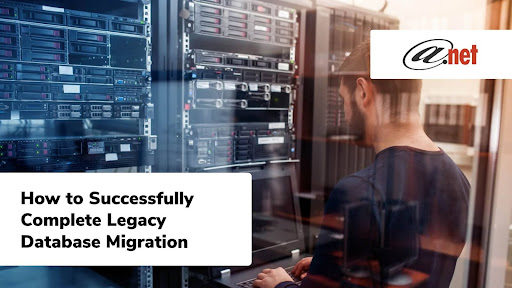
Migrating legacy data can be a daunting task for many organizations. The challenge lies not just in the technical aspects but also in ensuring that valuable historical information is preserved and seamlessly integrated into new systems.
This challenge is highlighted by the fact that 44% of CIOs believe that legacy systems are major barriers to company growth.
| As Joel K. Sosebee, Director of Sales at AT-NET, says, “Transitioning from legacy systems is a transformative move towards smarter, more efficient business operations.” |
This blog explores the essential steps and strategies for successful legacy data migration.
What Is a Legacy Data Systems Migration? Why is It Important?
Legacy data systems are typically built on older technologies that were cutting-edge at the time of implementation but have since become outdated software. These systems often store a vast amount of historical data that is crucial for business operations.
However, as technology evolves, these legacy systems start to pose significant challenges. They may not integrate well with newer technologies, leading to inefficiencies in data management and access.
Additionally, the maintenance of these outdated systems can be costly and time-consuming, diverting resources from more strategic initiatives. As a result, these legacy systems can become a bottleneck for businesses, hindering their ability to grow and innovate
Is Legacy Data Holding Your Business Back?ATNET simplifies your transition with expert legacy data migration services. |
7 Essential Steps for a Successful Data Migration from Legacy Systems
Now that we know what legacy systems are and why it is necessary, let’s understand what legacy system migration involves and how you can successfully complete your own data migration project by following these simple steps:
1.Develop a Comprehensive Migration Strategy
This crucial first step involves crafting a detailed plan for your migration legacy systems project. It’s not just about transferring existing data; it’s about understanding the broader implications of the move, including impacts on business processes and cloud migration considerations.
Define the specific legacy database elements and data sets to be transferred, and establish realistic timelines that reflect the complexity of your existing systems.
2. Assess Data Quality
Assessing the quality of the data in your legacy database is vital. This step goes beyond just looking at the data’s current state; it involves understanding how this data has been used in your business processes.
Cleanse and organize this historic data to ensure its accuracy and relevance in the new system, considering the regulatory requirements that might affect how data should be handled and stored.
3. Choose the Right Data Migration Tools
Selecting appropriate tools for the migration of legacy systems is a pivotal decision. These tools should not only facilitate the transfer of existing data but also ensure the integration of this data into the new system.
The compatibility with cloud infrastructure and the ability to handle different data sets efficiently are key factors to consider.
4. Test the Migration Process
Rigorous testing of the migration process is essential to ensure that migrating legacy systems do not result in data loss or corruption.
This step involves checking both the integrity of the data and the functionality of the new system, ensuring that all business processes are running as expected after the migration.
5. Ensure Data Integration
Successful legacy system migration strategies involve seamless integration of migrated data into the new system.
This is crucial for maintaining data coherence and ensuring that business processes are not disrupted. The integration should be planned in a way that supports both existing operations and any new capabilities offered by the new system.
6. Train Your Team
Effective migration legacy systems projects consider the human element. Training your team is essential to ensure they are equipped to handle the new system. This involves understanding the nuances of data integration and how the new system supports your business processes.

7. Monitor Post-Migration
Continuous monitoring after the legacy systems migration is crucial.
This step is about more than just troubleshooting; it’s about ensuring that the new system supports your business processes effectively and meets all regulatory requirements. Regularly check data quality and system performance to address any issues promptly.
Comparing Legacy Data Migration: In-House Process vs. Managed IT Service Approach
| Step | In-House Process | Managed IT Service |
| 1. Planning | Often lacks a detailed strategy; and may overlook key aspects | Comprehensive, strategic planning with expertise in legacy migrations |
| 2. Assessing Data Quality | Limited by in-house tools and expertise | Utilizes advanced tools and expertise for thorough data quality assessment |
| 3. Choosing Migration Tools | Restricted to available resources and knowledge | Access to a wide range of cutting-edge migration tools and technologies |
| 4. Testing | Potentially inadequate due to resource constraints | Extensive, rigorous testing to ensure data integrity and system compatibility |
| 5. Data Integration | Challenges in seamless integration with new systems | Expert integration ensuring coherence with existing and new systems |
| 6. Training & Support | Dependent on internal resources and knowledge | Comprehensive training and ongoing support provided by IT experts |
| 7. Monitoring & Optimization | Limited capability for continuous monitoring and optimization | Continuous monitoring and proactive optimization for peak performance |
| 8. Risk Management | Potential gaps in risk assessment and mitigation | Strategic risk management approaches tailored to specific business needs |
| 9. Compliance & Security | Basic compliance adherence, potential security gaps | Ensures highest standards of compliance and advanced security measures |
| 10. Cost & Time Efficiency | Risk of unforeseen expenses and extended timelines | Predictable costs and efficient timelines due to managed service expertise |
| More resources you might like: |
Partner With the Right MSP to Perform Your Legacy Data Migration Successfully
A recent study by Bloor Research put the failure rate for data migration projects at 38%. Now more than ever, businesses tasked with migrating data from legacy systems often seek the help of experienced managed services providers to ensure accuracy and efficiency. The primary benefit of this approach is a successful data migration effort right from the start.
AT-NET, with its extensive experience in conducting legacy data migrations for a wide range of businesses, is well-equipped to handle your migration needs.
| Discover Our Trusted Managed IT Services Near You |
Learn more about our services and competitive pricing by arranging a free consultation with us. Together, we’ll ensure your legacy data migration is set for success.



